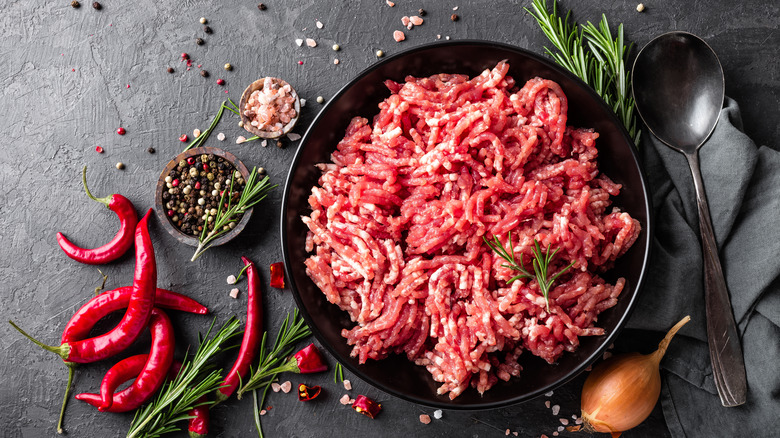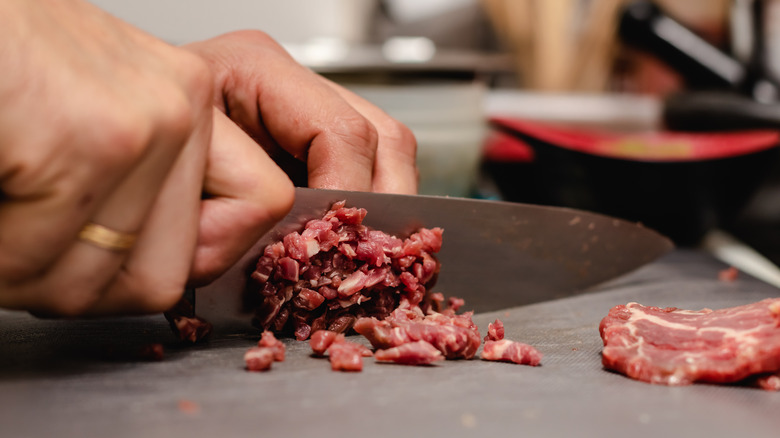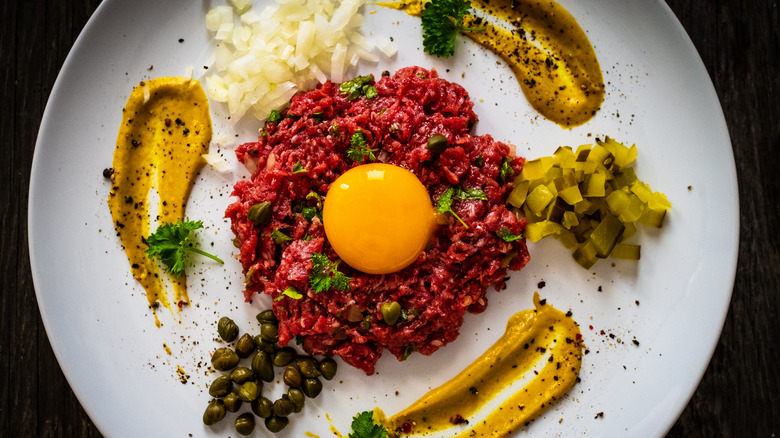What Exactly Is Beef Mince And Is It The Same As Ground Beef?
While the term "mince" is often applied to ground beef, both have important differences to keep in mind. Ground meat passes through a grinder until it resembles smooth strings with a consistent texture. Mince, on the other hand, is fed through large chopping machines or chopped by hand to create extremely small slivers.
Ground beef can be made up of multiple cuts, unless it specifies particular cuts like ground sirloin or brisket. According to the USDA, it can contain no more than 30% fat, which must come from the cut itself. Ground beef can contain additional seasonings, but if it includes added beef fat, it must be labeled "hamburger" meat. Neither ground beef nor hamburger meat can contain added "water, phosphates, extenders[,] or binders."
Mince may also consist of multiple cuts, and its fat content depends entirely on the type of meat used to make it. Unlike ground beef, it never includes additional ingredients beyond meat. Like grinding, mincing is a great way to take tough protein and make it tender by breaking it down into small, uniform pieces. Mince retains its texture once cooked, like small flakes of protein, rather than melting into the dish like ground beef. Mince is chunkier and chewier than ground beef, but can still be used in similar dishes, like in this beef kebab with pomegranate chutney recipe.
Understanding the nuances of taste and texture between each form of beef is important. It helps you identify which you need and which you may substitute, depending on your recipe.
Differences in taste and texture
Both forms of beef often come loaded with umami. Heavily exercised muscles — the tough ones often used for ground and minced beef — have far more of the satisfying fifth flavor than tender cuts like filet mignon. However, they do have some subtle differences.
Ground beef often tastes richer, especially if you buy a variety closer to 30% fat. Ground beef also imparts flavor better, because it breaks down into much smaller pieces once cooked. It hardly requires any chewing, and can melt into slow-cooked recipes like Bolognese. Chefs opt for a fine grind when they need something to straddle the line between texture and flavor base.
Mince, on the other hand, isn't well-suited to blending into the background. Its iconically tender and meatier flavor shines when it's made the centerpiece of a dish, like in a mince pie. Since it's not ground to a paste, each small flake contains a different ratio of meat and fat. This creates an irregular texture but a satisfying taste, more similar to shaved beef than ground.
Both ground and minced beef have their niches in different recipes. Their flavors, textures, and fat contents must be considered, especially when thinking about substitutions. Knowing how to use both forms of meat allows you to tailor recipes to your exact preferences, and opens the door to experimentation.
When to use minced beef over ground
Ground and minced beef are similar, but that doesn't mean they don't each have their respective strengths. For something like a shepherd's pie recipe, they're largely interchangeable. This is because the dish focuses on the beef, and doesn't rely on the meat keeping a specific shape or having a precise fat ratio. However, sometimes you need to choose one over the other.
Some recipes need a bit of chewiness to excel, so you should always opt for mince. Anthony Bourdain's tip for making better steak tartare at home illustrates the differences between the two nicely. You don't want to grind the muscle fibers into a paste, as this creates a soggier end product. Instead, aim to slice right through them until they're small enough to chew easily while still providing some texture.
Compare this to the classic all-American cheeseburger, which requires broken-down muscle fibers to effectively form a patty. Mince may fall apart on the grill or after a bite, and may not have the right meat-to-fat ratio. However, ground beef doesn't always hold its shape firmly either. For example, this classic grass-fed beef chili recipe calls for breaking up the meat as it browns, ensuring that there are no oversized chunks in the final product.



